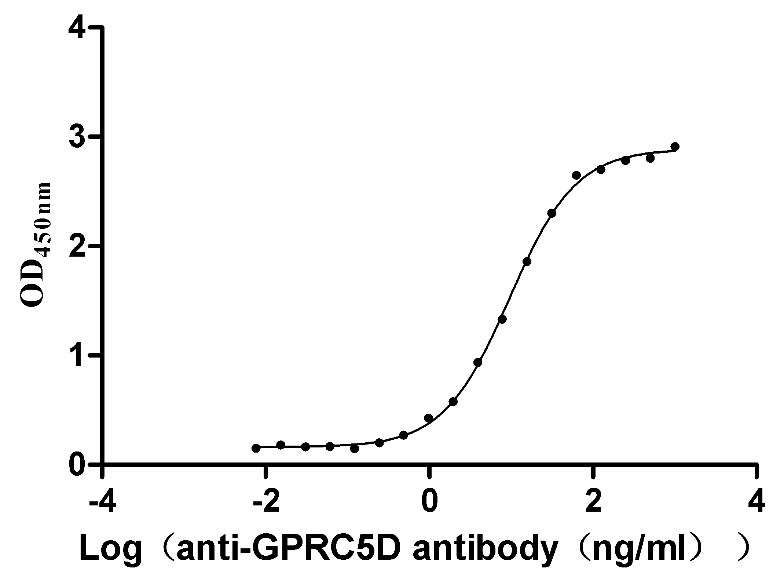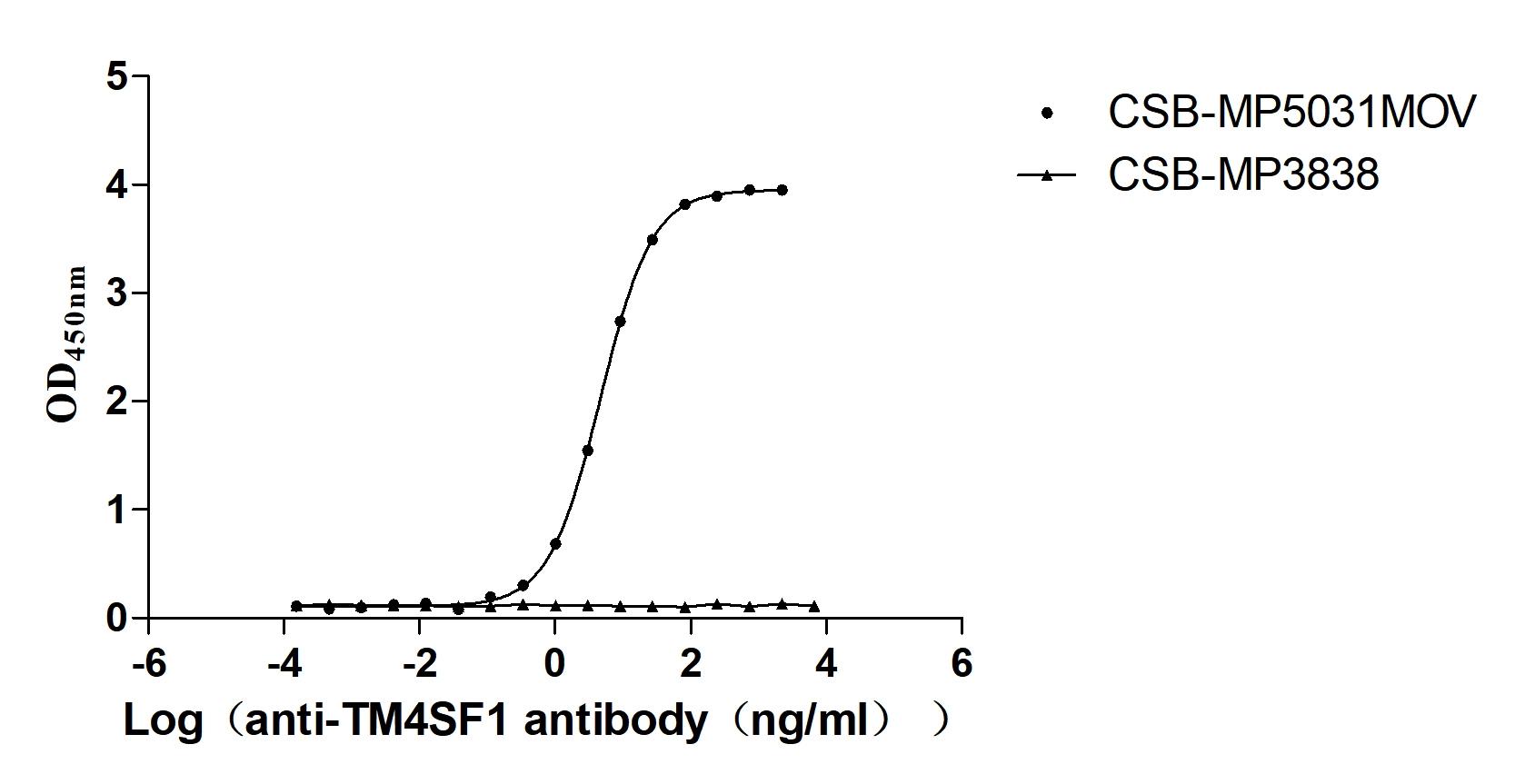Recombinant Human UDP-glucuronosyltransferase 2B15 (UGT2B15), partial
-
中文名称:人UGT2B15重组蛋白
-
货号:CSB-YP025589HU
-
规格:
-
来源:Yeast
-
其他:
-
中文名称:人UGT2B15重组蛋白
-
货号:CSB-EP025589HU
-
规格:
-
来源:E.coli
-
其他:
-
中文名称:人UGT2B15重组蛋白
-
货号:CSB-EP025589HU-B
-
规格:
-
来源:E.coli
-
共轭:Avi-tag Biotinylated
E. coli biotin ligase (BirA) is highly specific in covalently attaching biotin to the 15 amino acid AviTag peptide. This recombinant protein was biotinylated in vivo by AviTag-BirA technology, which method is BriA catalyzes amide linkage between the biotin and the specific lysine of the AviTag.
-
其他:
-
中文名称:人UGT2B15重组蛋白
-
货号:CSB-BP025589HU
-
规格:
-
来源:Baculovirus
-
其他:
-
中文名称:人UGT2B15重组蛋白
-
货号:CSB-MP025589HU
-
规格:
-
来源:Mammalian cell
-
其他:
产品详情
-
纯度:>85% (SDS-PAGE)
-
基因名:UGT2B15
-
Uniprot No.:
-
别名:EC 2.4.1.17; HLUG4; UDB15_HUMAN; UDP glucuronosyltransferase 2 family polypeptide B15; UDP glucuronosyltransferase 2 family; member B15; UDP glucuronosyltransferase 2 family; member B8; UDP glucuronosyltransferase 2B15; UDP glucuronosyltransferase UGT2B15; UDP glucuronyltransferase family 2 beta 15; UDP glycosyltransferase 2 family; member B15; UDP glycosyltransferase 2B15; UDP-glucuronosyltransferase 2B15; UDP-glucuronosyltransferase 2B8; UDPGT 2B15; UDPGT 2B8; UDPGT2B15; UDPGTh 3; UDPGTh-3; UDPGTH3; UGT2B15; UGT2B8; Uridine diphosphate glucuronosyltransferase 2 family; member B8; Uridine diphosphate glycosyltransferase 2 family; member B15
-
种属:Homo sapiens (Human)
-
蛋白长度:Partial
-
表达区域:24-494aa
-
氨基酸序列GKVLVWPTEYSHWINMKTILEELVQRGHEVTVLTSSASTLVNASKSSAIKLEVYPTSLTKNYLEDSLLKILDRWIYGVSKNTFWSYFSQLQELCWEYYDYSNKLCKDAVLNKKLMMKLQESKFDVILADALNPCGELLAELFNIPFLYSLRFSVGYTFEKNGGGFLFPPSYVPVVMSELSDQMIFMERIKNMIHMLYFDFWFQIYDLKKWDQFYSEVLGRPTTLFETMGKAEMWLIRTYWDFEFPRPFLPNVDFVGGLHCKPAKPLPKEMEEFVQSSGENGIVVFSLGSMISNMSEESANMIASALAQIPQKVLWRFDGKKPNTLGSNTRLYKWLPQNDLLGHPKTKAFITHGGTNGIYEAIYHGIPMVGIPLFADQHDNIAHMKAKGAALSVDIRTMSSRDLLNALKSVINDPVYKENVMKLSRIHHDQPMKPLDRAVFWIEFVMRHKGAKHLRVAAHNLTWIQYHSLDV
-
蛋白标签:Tag type will be determined during the manufacturing process.
The tag type will be determined during production process. If you have specified tag type, please tell us and we will develop the specified tag preferentially. -
产品提供形式:Lyophilized powder
Note: We will preferentially ship the format that we have in stock, however, if you have any special requirement for the format, please remark your requirement when placing the order, we will prepare according to your demand. -
复溶:We recommend that this vial be briefly centrifuged prior to opening to bring the contents to the bottom. Please reconstitute protein in deionized sterile water to a concentration of 0.1-1.0 mg/mL.We recommend to add 5-50% of glycerol (final concentration) and aliquot for long-term storage at -20℃/-80℃. Our default final concentration of glycerol is 50%. Customers could use it as reference.
-
储存条件:Store at -20°C/-80°C upon receipt, aliquoting is necessary for mutiple use. Avoid repeated freeze-thaw cycles.
-
保质期:The shelf life is related to many factors, storage state, buffer ingredients, storage temperature and the stability of the protein itself.
Generally, the shelf life of liquid form is 6 months at -20°C/-80°C. The shelf life of lyophilized form is 12 months at -20°C/-80°C. -
货期:Delivery time may differ from different purchasing way or location, please kindly consult your local distributors for specific delivery time.Note: All of our proteins are default shipped with normal blue ice packs, if you request to ship with dry ice, please communicate with us in advance and extra fees will be charged.
-
注意事项:Repeated freezing and thawing is not recommended. Store working aliquots at 4°C for up to one week.
-
Datasheet :Please contact us to get it.
靶点详情
-
功能:UDP-glucuronosyltransferase (UGT) that catalyzes phase II biotransformation reactions in which lipophilic substrates are conjugated with glucuronic acid to increase the metabolite's water solubility, thereby facilitating excretion into either the urine or bile. Essential for the elimination and detoxification of drugs, xenobiotics and endogenous compounds. Catalyzes the glucuronidation of endogenous steroid hormones such as androgens (testosterone, androsterone) and estrogens (estradiol, epiestradiol, estriol, catechol estrogens). Displays glucuronidation activity toward several classes of xenobiotic substrates, including phenolic compounds (eugenol, 4-nitrophenol, 4-hydroxybiphenyl) and phenylpropanoids (naringenin, coumarins). Catalyzes the glucuronidation of monoterpenoid alcohols such as borneol, menthol and isomenthol, a class of natural compounds used in essential oils.
-
基因功能参考文献:
- High UGT2B15 expression is associated with the pathogenesis of gastric cancer. PMID: 30066917
- Results found no significant increased risk for benign prostatic hyperplasia (BPH) in men with low activity genotype at D85Y, but found rather, a significant association between UGT2B15 D85Y and BPH risk when it is in combination with the UGT2B17 copy number variation. PMID: 28882566
- the UGT2B15 and UGT2B17 enzymes are transcriptionally regulated by sex hormone signaling in ERalpha+ breast cancer cells and are highly expressed in a subset of primary breast cancers. PMID: 27496708
- UGT2B15 genotype contributes to postoperative anxiety reduction after lorazepam premedication. PMID: 27622723
- Report frequency of UGT2B15 genetic polymorphisms in Pakistani population and genotype/phenotype correlation for glucuronidation of paracetamol. PMID: 27383482
- CYP3A4, CYP3A7, UGT2B11 and UGT2B15 genes are significantly downregulated in melanosis coli. PMID: 26238215
- miR-376c is inversely linked to UGT2B15 and UGT2B17 expression in high-grade prostate cancer and metastasis.UGT2B15 and UGT2B17 genes are direct targets of miR-376c and thus may influence steroid metabolism during prostate cancer progression. PMID: 26385605
- Data suggest that both 17beta-estradiol and the antiestrogen 4-OHTAM (4-hydroxytamoxifen, a metabolite of tamoxifen and substrate of UGT2B15) up-regulate UGT2B15 in breast cancer cells via the same estrogen receptor alpha- (ERa-)signaling pathway. PMID: 25795461
- Hepatic UGT2B15 protein onset begins in late gestation; however, the greatest rate of change occurs during the first few weeks after birth. PMID: 24980262
- Expression of UGT2B15 and UGT2B17 is negatively regulated by the binding of miR-376c. PMID: 26163549
- UGT2B15 genotype is a major determinant for differences in fasting plasma glucose and HbA1c response to sipoglitazar treatment between Type 2 Diabetes mellitus patients, due to related differences in drug exposure. PMID: 24214217
- A haplotype in UGT2B15 containing a functional variant (rs4148269, K523T) and an intronic SNP (rs6837575) was found to affect rectal cancer risk overall (OR = 2.57, 95% CI = 1.21-5.04) and in females (OR = 3.08, 95% CI = 1.08-8.74). PMID: 24822274
- In the tamoxifen-treated subgroup poor prognosis was related to the combined presence of ESR1 PvuII wt/wt and UGT2B15 wt/wt or wt/*2 genotype. PMID: 23951298
- Novel associations between UGT2B15 and UGT2B17 single nucleotide polymorphism variants and prostate cancer risk. PMID: 24267955
- UGT2B15 is a possible target for androgen deprivation therapy of prostate cancer. PMID: 24121496
- Report the influence of functionally relevant polymorphic UGT2B15, the enzyme mediating bisphenol A metabolism using kinetic based modelling. PMID: 23404680
- Sipoglitazar clearance is substantially modified by UGT2B15 enzyme variants, with higher exposure observed in the UGT2B15*2/*2 genotype group. PMID: 22960998
- Report UGT2B15 expression in fetal/adult tissues. PMID: 23223495
- Data indicates that 2B15 requires regulated phosphorylation by both PKCalpha and Src, which is consistent with the complexity of synthesis and metabolism of its major substrate, DHT. PMID: 22532564
- The study revealed that UGT2B15 and UGT2B17 are differentially regulated during prostate cancer progression. PMID: 22170718
- For UGT2B15, the percentage of APAPG decreased (P < 0.0001) and that of APAP sulfate increased (P = 0.002) in an allelic dose-dependent manner across genotypes from *1/*1 to *2/*2. PMID: 21666065
- The D85Y substitution in UGT2B15 decreases enzymatic function, and the polymorphic alleles of UGT2B15 are closely associated with variations in the metabolism and toxicity of bisphenol A. PMID: 21404072
- Data show that steroidogenic enzymes (AKR1C3, HSD17B2, UGT2B15 and UGT2B17) and stem/progenitor cell markers CK5 and ABCG2 were upregulated in castration resistant prostate cancer. PMID: 21365123
- regulation of the UGT2B15 and UGT2B17 genes by FOXA1 may have an important role in the maintenance of androgen homeostasis within prostate cancer cells. PMID: 20736324
- SNPs in strong linkage disequilibrium with G253T regulate UGT2B15 expression in liver. PMID: 19847790
- UGT2B15 polymorphism cannot be considered as a susceptibility marker for prostate cancer, but it involoved in glucuronidation of numerous phytochemicals. This polymorphism could contribute to interindividual variability in chemopreventive effects. PMID: 12010866
- Single-nucleotide polymorphisms (SNPs) were found in UGT2B15 gene PMID: 12376738
- The alteration of UGT2B15 expression in LNCaP-SF cells is proposed as a biological characteristic involved in the growth of hormone-refractory prostate cancer. PMID: 12646996
- Although D85 and Y85 appear to be common variants, we cannot exclude the possibility that the UGT2B15 gene represents a minor modifying locus. PMID: 12880121
- In human prostate, UGT2B15 and UGT2B17 genes have complementary roles and are expressed in cells where their specific substrates are synthesized. PMID: 15666817
- Tamoxifen-treated patients with UGT2B15 high activity genotypes had increased risk of recurrence PMID: 15952058
- estrogen-induced up-regulation of UGT2B15 might have a significant moderating effect on estrogen and androgen concentrations, thereby reducing their signaling in breast cancer cells PMID: 16690804
- 5-(4'-Hydroxyphenyl)-5-phenylhydantoin O-glucuronide formation in human liver microsomes is catalyzed by UGT1A1, UGT1A9, and UGT2B15 in a stereoselective manner PMID: 17576806
- UGT2B15 and -B17 are critical enzymes for the local inactivation of androgens and that glucuronidation is a major determinant of androgen action in prostate cells PMID: 17848572
- Androsterone reduces the glucuronidation of androgens catalysed by UGT2B15 and UGT2B17 in a prostate tumor cell line. PMID: 17988216
- Vitamin D receptor activator calcitriol as a negative regulator of the UGT2B15- and UGT2B17-dependent inactivation of androgens in prostate cancer LNCaP cells. PMID: 18281521
- UGT2B15 ia a primary androgen-regulated genes and androgen receptor is required for basal expression and androgen-regulated expression. PMID: 18302198
- Estrogen receptor alpha, fos-related antigen-2, and c-jun coordinately regulate human UGT2B15 expression in response to 17beta-estradiol in MCF-7 cells. PMID: 19487245
- UGT2B15 functional polymorphism along with Copy-number variations PMID: 19572376
- Clinical trial of gene-environment interaction and pharmacogenomic / toxicogenomic. (HuGE Navigator) PMID: 17244352
- Gender and UGT2B15 D85Y genotype are identified as major determinants of S-oxazepam glucuronidation by human liver and may explain in part polymorphic oxazepam glucuronidation by human subjects. PMID: 15044558
- S-oxazepam is stereoselectively glucuronidated by UGT2B15, whereas R-oxazepam is glucuronidated by multiple UGT isoforms. Allelic variation associated with the UGT2B15 gene may explain polymorphic S-oxazepam glucuronidation in humans. PMID: 12386133
显示更多
收起更多
-
亚细胞定位:Endoplasmic reticulum membrane; Single-pass membrane protein.
-
蛋白家族:UDP-glycosyltransferase family
-
组织特异性:Expressed in many tissues. Present in liver, prostate and testis.
-
数据库链接:
HGNC: 12546
OMIM: 600069
KEGG: hsa:7366
STRING: 9606.ENSP00000341045
UniGene: Hs.150207
Most popular with customers
-
Recombinant Human Glucagon receptor (GCGR), partial (Active)
Express system: Mammalian cell
Species: Homo sapiens (Human)
-
Recombinant Human Angiopoietin-2 (ANGPT2) (Active)
Express system: Mammalian cell
Species: Homo sapiens (Human)
-
Recombinant Human G-protein coupled receptor family C group 5 member D (GPRC5D)-VLPs (Active)
Express system: Mammalian cell
Species: Homo sapiens (Human)
-
Recombinant Rat Gastric inhibitory polypeptide receptor (Gipr), partial (Active)
Express system: Mammalian cell
Species: Rattus norvegicus (Rat)
-
Recombinant Human CD81 antigen (CD81), partial (Active)
Express system: Mammalian cell
Species: Homo sapiens (Human)
-
Recombinant Macaca fascicularis Transmembrane 4 L6 family member 1 (TM4SF1)-VLPs (Active)
Express system: Mammalian cell
Species: Macaca fascicularis (Crab-eating macaque) (Cynomolgus monkey)
-
Recombinant Human Kidney-associated antigen 1(KAAG1) (Active)
Express system: E.coli
Species: Homo sapiens (Human)
-
Express system: Mammalian cell
Species: Homo sapiens (Human)



-AC1.jpg)
















